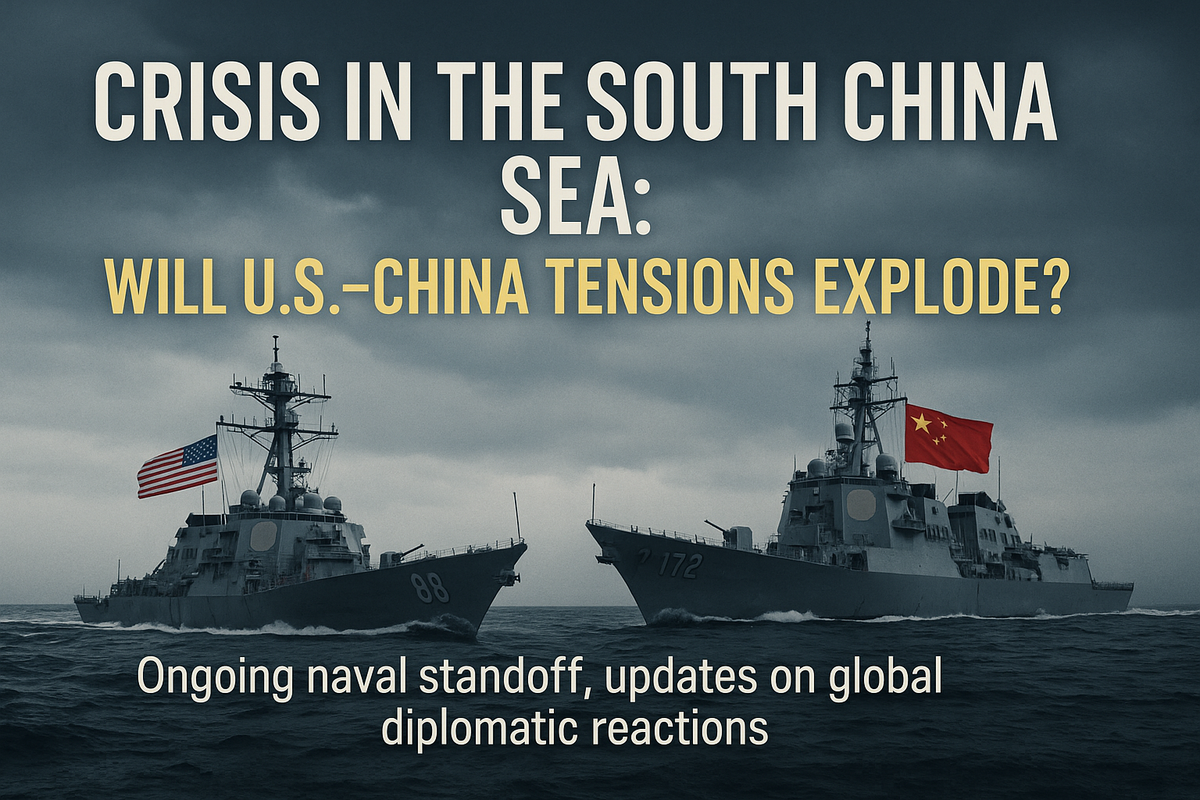Crisis in the South China Sea: Will U.S.–China Tensions Explode?"
Rising military maneuvers and territorial claims have turned the South China Sea into a flashpoint. As U.S.–China tensions escalate, the risk of conflict threatens regional stability and global trade.

Introduction
The South China Sea where more than $3 trillion in trade passes through each year is again at the center of a potentially disastrous conflict.
Over the last week, the U.S. Navy and the People's Liberation Army Navy (PLAN) of China have been involved in the most serious confrontation in almost a decade, publicly issuing threats, conducting provocative maneuvers, and getting the entire Indo-Pacific into high tension.
Diplomats worldwide are racing to diffuse the tensions, even as both fleets make displays of strength within 12 nautical miles of disputed reefs and islands claimed by Beijing but also Vietnam, the Philippines, Malaysia, and Taiwan.
This crisis has again raised searching questions:
- Might open war be triggered by collision or miscalculation?
- What do Washington and Beijing actually want?
- How are other countries responding and preparing?
The Latest Naval Flashpoints
Within the past 72 hours, several encounters have been noted:
- U.S. Littoral Combat Ship Gabrielle Giffords was tracked by two Chinese corvettes of the Type 056 off Mischief Reef. Chinese ships have made "unprofessional maneuvers" 150 meters from the American warship, said the U.S. Indo-Pacific Command.
- The PLAN sent a Type 055 Renhai-class destroyer, which is full of anti-ship missiles, to the Spratly Islands. Satellite photos placed it at anchor off Subi Reef, an artificial Chinese-occupied island.
- A U.S. Navy P-8 Poseidon surveillance plane flew over the region, prompting Beijing's Ministry of Defense to unleash a furious denunciation, calling the flight an "illegal intrusion."
- Chinese maritime militia vessels have been massing near the Philippine-claimed Second Thomas Shoal, with Manila warning of “gray zone tactics” meant to intimidate its coast guard.
One Pentagon official told Reuters:
“This is the closest we’ve come to a serious incident since 2016.”
Why the South China Sea Matters
The stakes here are enormous.
- Economic Lifeline:
~30% of international shipping goes through these waters, including energy resources vital to Japan, South Korea, and Taiwan.
- Military Access:
China's artificial islands have runways, radar arrays, and missile batteries potentially capable of projecting power far into the Pacific.
- Sovereignty Claims:
Beijing maintains it has "indisputable sovereignty" over almost all of the sea, grounded in its legally challenged nine-dash line, a claim rejected by an international court in 2016.
- Freedom of Navigation:
The U.S. is making "freedom of navigation operations" (FONOPs) to undermine Chinese claims and preserve open sea lanes.
- Alliance Commitments:
Alliances with the Philippines and security partnerships with Vietnam and Indonesia risk pulling Washington into direct confrontation should a clash occur.
What the U.S. Is Saying
U.S. Secretary of Defense Lloyd Austin made a blunt statement on July 12, 2025, from the Pentagon briefing room:
The United States will fly, sail, and operate where international law permits. We will not be intimidated into turning a blind eye to the world's capitals.
Behind the scenes, U.S. officials have characterized the confrontation as a moment of truth test of credibility. Privately, Washington has made clear to Beijing, according to two senior defense officials briefing anonymously with The New York Times, that it will respond with a "proportionate, deliberate response" if Beijing makes any move towards blockading or seizing more features—like Second Thomas Shoal or Scarborough Shoal.
Practically speaking, the Pentagon has already ratcheted up its stance:
- Sent more guided-missile destroyers from the 7th Fleet in Yokosuka, Japan, namely the USS Dewey and USS Barry, to carry out high-profile patrols up to 12 nautical miles off Chinese-occupied reefs.
- Expanded aerial surveillance flights, where U.S. Navy P-8 Poseidon aircraft are making almost daily flights over the Spratly and Paracel Islands. A senior defense official confirmed that reconnaissance drones are also offering 24-hour surveillance.
- Carried out massive joint exercises with the Philippine Navy off Palawan, practicing amphibious landings and missile defense.
One of the top U.S. Pacific Fleet commanders characterized the strategy as "persistent presence and integrated deterrence," explaining:
"We are not here to provoke, but to prevent Beijing from assuming it can alter the status quo by force."
Meanwhile, US diplomats have also indicated that Washington is willing to have direct military-to-military discussions to prevent miscalculations but Chinese officials have so far held out against involving any serious de-escalation mechanism.
Beijing's Position
Beijing has responded with equally strong rhetoric.
Foreign Ministry Spokesman Wang Wenbin, speaking to journalists in Beijing, said:
It is America that is raising tensions by dispatching warships thousands of miles from home. These are our waters since ancient times. So-called 'freedom of navigation' is just a pretext for violating our sovereignty."
During a TV item on CCTV, Chinese military pundits featured fresh footage of:
- Ballistic missile exercises close to Hainan, including DF-21D "carrier killer" anti-ship missile launches, intended to counter U.S. ships in the First Island Chain.
- Amphibious assault vessels such as the Type 075 landing helicopter dock conducting beach landings with marines.
- Hundreds of People's Liberation Army Navy-controlled civilian-painted maritime militia ships amassing around disputed reefs like Whitsun Reef and Second Thomas Shoal.
This combination of explicit military posturing and deniable gray-zone actions is now Beijing's trademark style.
Li Jie, a retired senior captain in the PLAN and regular commentator on Chinese state television, maintained:
"The U.S. has underestimated China's determination. This time, China will not step back."
Analysts say the words are part of an emerging wave of nationalism in the run-up to the Communist Party's next plenum, at which President Xi Jinping will seek to demonstrate his strongman credentials.
Diplomatic Responses
The crisis has provoked quick responses from allies and regional players:
Philippines:
President Ferdinand Marcos Jr. spoke to the nation in a live address, pledging to "defend our sovereign rights and our fishermen." The Philippine Navy deployed extra patrol ships, as well as urging ASEAN and the United Nations to denounce "coercive actions."
Vietnam:
Vietnam's Foreign Ministry called for "maximum restraint," but satellite photos verify it has also strengthened outposts on Spratly islands it occupies, such as Truong Sa Lon Island, and extended an airstrip.
Japan:
Foreign Minister Yoko Kamikawa issued a "grave concern," saying:
"The South China Sea needs to be considered free and open. Any unilateral action to alter the status quo is not acceptable.
Japan said it would hold trilateral naval drills with the United States and Australia in the Philippine Sea as a demonstration of solidarity.
Australia:
Prime Minister Anthony Albanese cautioned:
"The region cannot afford an accident or misjudgment to spiral into conflict."
Australia's Defense Department confirmed an Air Force P-8A Poseidon will be joining surveillance flights over the disputed waters.
India:
India has been careful. While echoing encouragement for freedom of navigation and overflight, New Delhi has avoided taking a clear side with Beijing or Washington, going for strategic ambiguity to maintain economic relationships.
ASEAN:
In an emergency session, ASEAN foreign ministers issued a joint communiqué calling for:
"All parties to exercise maximum restraint, avoid the threat or use of force, and pursue peaceful resolution through dialogue."
What Could Trigger Conflict?
Regional security analysts have found a number of potential flashpoints that can trigger a direct confrontation:
- A Collision:
A Chinese maritime militia or coast guard ship deliberately rammed a U.S. or Philippine warship, or there's an accidental collision in busy waters.
- A Military Misfire:
A warning shot or flare intended as intimidation crosses a line into live fire, and a response is had.
- A "Salami Slicing" Move:
China tries to land troops on an hitherto unoccupied reef or shoal particularly Second Thomas Shoal or Scarborough Shoal and the U.S. or Philippines will be forced to respond to kick them out.
- An Accident:
A drone crash, electronic warfare jamming, or radar misidentification precipitates an outburst of fire before the cooler heads prevail.
- A Crisis Over Taiwan:
A simultaneous escalation in the Taiwan Strait produces a wider confrontation in the South China Sea, tying the two theaters together.
Expert Analysis
Bonnie Glaser, Director of Indo-Pacific Program at the German Marshall Fund, said to The Financial Times:
"Both sides are trapped in deterrence signaling. The danger is not that each wants war, but that they might stumble into it by an accident or a series of miscalculations."
Collin Koh, a maritime security expert at Singapore's S. Rajaratnam School of International Studies, said:
"China thinks incremental advances will ultimately be accepted. America thinks only persistent pushback will deter them. This is a dangerous cycle of action and reaction."
U.S. Assistant Secretary of Defense for Indo-Pacific Security Affairs Ely Ratner has warned that today's environment is the most turbulent in a generation.
Why This Time Feels Different
Although South China Sea tensions have sometimes flared in the past 20 years, this crisis is remarkable for several reasons:
- China's military is currently the largest naval force in the world, with more than 360 warships and submarines, running dozens of more vessels than a decade before and having ongoing patrols.
- U.S.–China relations are already at their worst over Taiwan, technology export controls, human rights sanctions, and cyber intrusions.
- Both capitals' domestic politics reward hardline positions. In Washington, both sides are pushing for firmness, while in Beijing, any perceived weakness would encourage competing factions.
- There is no established crisis hotline procedure among the ships' naval commanders at sea. There are procedural protocols nominally in place, but they have yet to be tested under stress and can likely fail in a rapidly unfolding incident.
What Comes Next?
Most analysts expect the next weeks to witness ongoing brinksmanship and heightened risks:
- More U.S. freedom of navigation patrols, perhaps with allied involvement (Japan, Australia).
- Larger Chinese naval and air deployments to project claims over disputed reefs.
- Maritime militia swarming maneuvers to intimidate Southeast Asian claimants.
- Enhanced satellite surveillance and intelligence sharing by the "Quad" (U.S., Japan, Australia, India).
- ASEAN emergency summits and code-of-conduct framework proposals though these processes have time and again stalled.
Even after backchannel diplomacy, Beijing and Washington do not seem keen on scaling back their presence or giving up fundamental principles.
A top American defense official encapsulated the stakes bluntly:
"We are in uncharted waters. One mistake, and this could escalate fast."
Key Numbers at a Glance
- $3.4 trillion: Annual trade passing through the South China Sea
- ~1/3 of international shipping: Travels through these routes
- 300+ Chinese maritime militia ships: Stationed near disputed reefs
- 60+ U.S. Navy warships: Routinely patrol the Indo-Pacific theater
- 10+ nations: Have competing maritime claims
Why the World Needs to Care
This isn't merely a regional border dispute it may:
- Upset international trade and supply chains, increasing energy, electronics, and consumer goods prices.
- Embolden other repressive powers to challenge U.S. determination in other regions, from the Taiwan Strait to the Persian Gulf.
- Spark a weapons race, as countries ramp up submarine and anti-ship missile projects.
- Result in direct conflict between nuclear powers, with devastating repercussions.
What You Can Expect
In the days and weeks ahead, look out for these developments:
- Any ship or air collision or close-quarters operation
- Chinese efforts at blockade or capture of further features
- U.S. pronouncements of additional deployments or freedom of navigation operations
- ASEAN emergency meetings or diplomatic moves
- Financial markets responding to indicators of escalation or de-escalation
Bookmark this page and sign up for our newsletter for real-time news, satellite images, and expert comment as this crisis unfolds.
Sources
- Reuters
- Al Jazeera
- BBC
- South China Morning Post
- U.S. Department of Defense
- Chinese Ministry of Foreign Affairs
- Asia Maritime Transparency Initiative
For more legal exposes and truth-behind-glamour stories, subscribe to AllegedlyNewsNetwork.com




